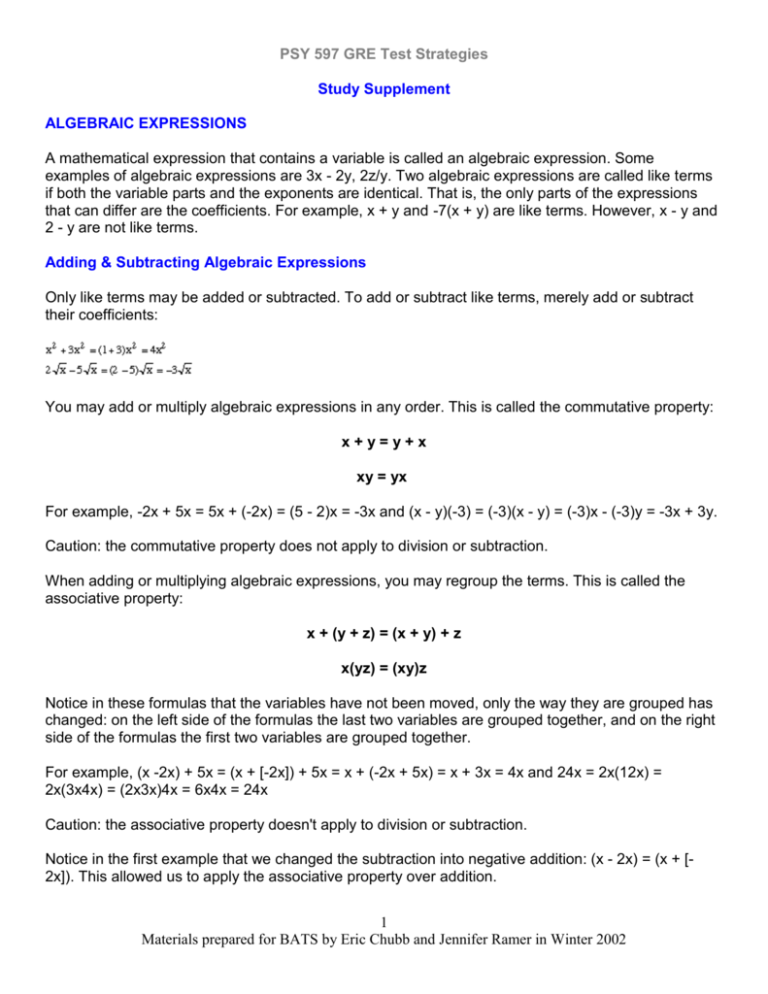Algebraic Equations
advertisement

PSY 597 GRE Test Strategies Study Supplement ALGEBRAIC EXPRESSIONS A mathematical expression that contains a variable is called an algebraic expression. Some examples of algebraic expressions are 3x - 2y, 2z/y. Two algebraic expressions are called like terms if both the variable parts and the exponents are identical. That is, the only parts of the expressions that can differ are the coefficients. For example, x + y and -7(x + y) are like terms. However, x - y and 2 - y are not like terms. Adding & Subtracting Algebraic Expressions Only like terms may be added or subtracted. To add or subtract like terms, merely add or subtract their coefficients: You may add or multiply algebraic expressions in any order. This is called the commutative property: x+y=y+x xy = yx For example, -2x + 5x = 5x + (-2x) = (5 - 2)x = -3x and (x - y)(-3) = (-3)(x - y) = (-3)x - (-3)y = -3x + 3y. Caution: the commutative property does not apply to division or subtraction. When adding or multiplying algebraic expressions, you may regroup the terms. This is called the associative property: x + (y + z) = (x + y) + z x(yz) = (xy)z Notice in these formulas that the variables have not been moved, only the way they are grouped has changed: on the left side of the formulas the last two variables are grouped together, and on the right side of the formulas the first two variables are grouped together. For example, (x -2x) + 5x = (x + [-2x]) + 5x = x + (-2x + 5x) = x + 3x = 4x and 24x = 2x(12x) = 2x(3x4x) = (2x3x)4x = 6x4x = 24x Caution: the associative property doesn't apply to division or subtraction. Notice in the first example that we changed the subtraction into negative addition: (x - 2x) = (x + [2x]). This allowed us to apply the associative property over addition. 1 Materials prepared for BATS by Eric Chubb and Jennifer Ramer in Winter 2002 Parentheses When simplifying expressions with nested parentheses, work from the inner most parentheses out: 5x + (y - (2x - 3x)) = 5x + (y - (-x)) = 5x + (y + x) = 6x + y Sometimes when an expression involves several pairs of parentheses, one or more pairs are written as brackets. This makes the expression easier to read: 2x(1 -[y + 2(3 - y)]) = 2x(1 -[y + 6 - 2y]) = 2x(1 -[-y + 6]) = 2x(1 + y - 6) = 2x(y - 5) = 2xy - 10x Order of Operations: (PEMDAS) When simplifying algebraic expressions, perform operations within parentheses first and then exponents and then multiplication and then division and then addition and then subtraction. This can be remembered by the mnemonic: PEMDAS Please Excuse My Dear Aunt Sally GRAPHS Questions involving graphs rarely involve any significant calculating. Usually, the solution is merely a matter of interpreting the graph. 1. During which year was the company's earnings 10 percent of its sales? (A) 85 (B) 86 (C) 87 (D) 88 (E) 90 2 Materials prepared for BATS by Eric Chubb and Jennifer Ramer in Winter 2002 Reading from the graph, we see that in 1985 the company's earnings were $8 million and its sales were $80 million. This gives 8/80 = 1/10 = 10/100 = 10%. The answer is (A). 2. During what two-year period did the company's earnings increase the greatest? (A) 85-87 (B) 86-87 (C) 86-88 (D) 87-89 (E) 88-90 Reading from the graph, we see that the company's earnings increased from $5 million in 1986 to $10 million in 1987, and then to $12 million in 1988. The two-year increase from '86 to '88 was $7 million-clearly the largest on the graph. The answer is (C). 3. During the years 1986 through 1988, what were the average earnings per year? (A) 6 million (B) 7.5 million (C) 9 million (D) 10 million (E) 27 million The graph yields the following information: Year Earnings 1986 $5 million 1987 $10 million 1988 $12 million Forming the average yields (5 + 10 + 12)/3 = 27/3 = 9. The answer is (C). 4. If Consolidated Conglomerate's earnings are less than or equal to 10 percent of sales during a year, then the stockholders must take a dividend cut at the end of the year. In how many years did the stockholders of Consolidated Conglomerate suffer a dividend cut? (A) None (B) One (C) Two (D) Three (E) Four Calculating 10 percent of the sales for each year yields Year 10% of Sales (millions) Earnings (millions) 85 .10 x 80 = 8 8 86 .10 x 70 = 7 5 87 .10 x 50 = 5 10 88 10 x 80 = 8 12 89 .10 x 90 = 9 11 90 .10 x 100 = 10 8 Comparing the right columns shows that earnings were 10 percent or less of sales in 1985, 1986, and 1990. The answer is (D). 3 Materials prepared for BATS by Eric Chubb and Jennifer Ramer in Winter 2002








